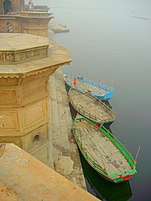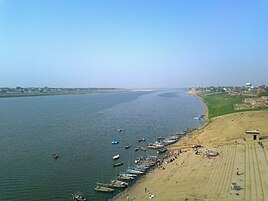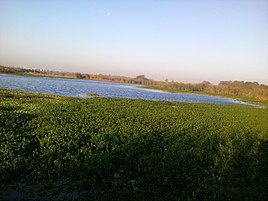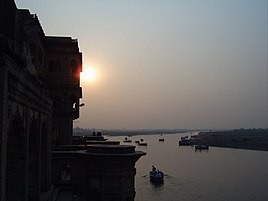Yamuna
| Yamuna | |
|---|---|
Yamuna Nagar Uttar Pradesh: Kairana and Baghpat Uttar Pradesh: Noida, Mathura, Vrindavan, Agra, Firozabad, Etawah, Auraiya and Prayagraj | |
| Physical characteristics | |
| Source | Yamunotri |
| • location | Banderpooch peaks, Uttarkashi district, Uttarakhand, India |
| • coordinates | 31°01′0.12″N 78°27′0″E / 31.0167000°N 78.45000°E |
| • elevation | 4,500 m (14,800 ft)[1] |
| Mouth | Ganges |
• location | Triveni Sangam, Prayagraj, India |
• coordinates | 25°25′11.44″N 81°53′5.80″E / 25.4198444°N 81.8849444°E |
• elevation | 74 m (243 ft) |
| Length | 1,376 km (855 mi) |
| Basin size | 366,223 km2 (141,399 sq mi) |
| Discharge | |
| • location | Prayagraj[2] |
| • average | 2,950 m3/s (104,000 cu ft/s) |
| Basin features | |
| Tributaries | |
| • left | Sasur Khaderi |
| • right | Giri, Baghain, Sabi, Chambal, Betwa, Sindh, Ken |
The Yamuna (IAST: Yamunā; pronounced [jəmʊnɑː]) is the second-largest tributary river of the Ganges by discharge and the longest tributary in India. Originating from the Yamunotri Glacier at a height of about 4,500 m (14,800 ft)[1] on the southwestern slopes of Bandarpunch peaks of the Lower Himalaya in Uttarakhand, it travels 1,376 kilometres (855 mi) and has a drainage system of 366,223 square kilometres (141,399 sq mi), 40.2% of the entire Ganges Basin. It merges with the Ganges at Triveni Sangam, Prayagraj , which is a site of the Kumbh Mela, a Hindu festival held every 12 years.
Like the Ganges, the Yamuna is highly venerated in Hinduism and worshipped as the goddess Yamuna. In Hinduism, she is believed to be the daughter of the sun god, Surya, and the sister of Yama, the god of death, and so she is also known as Yami. According to popular Hindu legends, bathing in Yamuna's sacred waters frees one from the torments of death.[3][4]
The river crosses several states such as
Nearly 57 million people depend on the Yamuna's waters, and the river accounts for more than 70 percent of Delhi's water supply. It has an annual flow of 97 billion cubic metres, and nearly 4 billion cubic metres are consumed every year (of which irrigation constitutes 96%).
The water quality in Upper Yamuna, as the 375-kilometre (233 mi) long stretch of Yamuna is called from its origin at Yamunotri to Okhla barrage,[6] is of "reasonably good quality" until the Wazirabad barrage in Delhi. Below this, the discharge of wastewater in Delhi through 15 drains between Wazirabad barrage and Okhla barrage renders the river severely polluted. Wazirabad barrage to Okhla Barrage, 22 km (14 mi) stretch of Yamuna in Delhi, is less than 2% of Yamuna's total length but accounts for nearly 80% of the total pollution in the river.[7] Untreated wastewater and poor quality of water discharged from the wastewater treatment plants are the major reasons of Yamuna's pollution in Delhi. To address river pollution, measures have been taken by the Ministry of Environment and Forests (MoEF) under the Yamuna Action Plan (YAP) which has been implemented since 1993 by the MoEF's National River Conservation Directorate (NRCD).
Basin

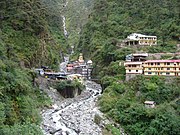

Palaeochannels: Sarasvati's tributary
The present
Sources: Banderpoonch peak and Yamunotri glacier
The source of Yamuna lies in the Yamunotri Glacier at an elevation of 6,387 metres (20,955 ft), on the southwestern slopes of Banderpooch peaks, which lie in the Mussoorie range of the Lower Himalayas, north of Haridwar in Uttarkashi district, Uttarakhand.[3] Yamunotri temple, a shrine dedicated to the goddess Yamuna, is one of the holiest shrines in Hinduism, and part of the Chota Char Dham Yatra circuit. Also standing close to the temple, on its 13-kilometre (8 mi) trek route that follows the right bank of the river, lies Markendeya Tirtha, where the sage Markandeya wrote the Markandeya Purana.[9][10]
Current channel
The river flows southwards for about 200 kilometres (120 mi), through the Lower Himalayas and the

From the upper catchment area, the river descends onto the plains of
The Yamuna defines the state borders between Himachal Pradesh and Uttarakhand, and between Haryana, Delhi and

| State | Catchment area (km2) | % of catchment area |
|---|---|---|
| Uttar Pradesh and Uttarakhand | 74,208 | 21.5 |
| Himachal Pradesh | 5,799 | 1.6 |
| Haryana | 21,265 | 6.5 |
| Rajasthan | 102,883 | 29.8 |
| Madhya Pradesh | 140,230 | 40.6 |
| Delhi | 1,485 | 0.4 |
Subsequently, the Yamuna flows through the states of Delhi, Haryana and Uttar Pradesh before merging with the
Important tributaries

Yamuna's tributaries make up 70.9% of the catchment area and the river has six important tributaries:[3]
- Tons River is Yamuna's largest tributary[15] and rises in the 6,315-metre-high (20,719 ft) Bandarpoonch mountain. It meets Yamuna below Kalsi, near Dehradun, Uttarakhand.[15]
- Shivalik, in the Lower Himalayan Range. It is a rain fed river and has a catchment area of 7,083 square kilometres (2,735 sq mi) and traverses 400 kilometres (250 mi).[15]
- Rana Pratap Sagar dam and Jawahar Sagar dam. The Chambal river merges with the Yamuna at Sahon village.[15]
- Kali River, rises in the Doon Valley and merges with the Hindon River.[3]
- Fatehpur in Uttar Pradesh. It has an overall drainage basin of 28,058 square kilometres (10,833 sq mi).[16]
- Betwa River originates in Bhopal district, in Madhya Pradesh. Its confluence with the Yamuna is in Hamirpur district, Uttar Pradesh. It has a catchment area of 46,580 km2 (17,980 sq mi).[16]
Background

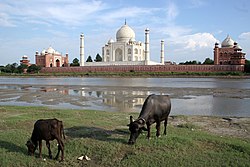
Etymology
The name Yamuna seems to be derived from the Sanskrit word "yama", meaning 'twin', and it may have been applied to the river because it runs parallel to the Ganges.[17]
History
The earliest mention of Yamuna is found at many places in the
Yamuna is mentioned as
Geological evidence indicates that in the distant past the Yamuna was a tributary of the
Most of the great
Use of water
1994 water sharing agreement
The stretch of the river from its origin at
Flood forecasting systems are established at Poanta Sahib, where Tons, Pawar and Giri tributaries meet. The river take 60 hours to travel from Tajewala to Delhi, thus allowing a two-day advance flood warning period.[3][26][27] The Central Water Commission started flood-forecasting services in 1958 with its first forecasting station on Yamuna at Delhi Railway Bridge.[28]
Barrages
Yamuna has the following six functional barrages (eight including old replaced barrages, nine including a new proposed barrage), from north-west to southeast:[29][30][31][32][needs update]
- Dakpathar Barrage in Uttarakhand, managed by the Uttarakhand government.
- Hathni Kund Barrage in Haryana, 172 km (107 mi) from the source of Yamuna, built in 1999 and managed by Haryana government.[33][34]
- Tajewala Barrage was built in 1873 and replaced by the Hathni Kund.[33][34]
- Wazirabad barrage in north Delhi, 244 km (152 mi) from Hathni Kund barrage, managed by the Delhi government.[35]
- "New Wazirabad barrage", proposed in 2013, to be built 8 km (5.0 mi) north of the Wazirabad barrage.
- ITO barrage (Indraparstha barrage) in central Delhi, managed by the Haryana govt.[35]
- Okhla barrage is 22 km (14 mi) from Wazirabad to south Delhi, managed by the Uttar Pradesh (UP) government.[35]
- New Okhla Barrage, a new barrage, managed by the UP government.[35]
- Palla barrage downstream on "Delhi-Faridabad canal" in Haryana, managed by the Haryana government.
- Gokul barrage (a.k.a. Mathura barrage) is at Gokul in Uttar Pradesh, managed by the UP government.
Irrigation

Use of the Yamuna's waters for irrigation in the
Eastern Yamuna Canal
As the Yamuna enters the Northern Plains near
Western Yamuna Canal
The Western Yamuna Canal (WYC) was built in 1335 CE by Firuz Shah Tughlaq. Excessive silting caused it to stop flowing c. 1750, when the British Raj undertook a three-year renovation in 1817 by Bengal Engineer Group. The Tajewala Barrage dam was built in 1832–33[timeframe?] to regulate the flow of water, and was replaced by the modern Hathni Kund Barrage in 1999.[37]
The main canal is 86 kilometres (53 mi) long.[37] When including its branches and many major and minor irrigation channels, it has a total length of 325 km (202 mi)[38] The WYC begins at the Hathni Kund Barrage about 38 km (24 mi) from Dakpathar and south of Doon Valley. The canals irrigate vast tracts of land in the region in Ambala, Karnal, Sonipat, Rohtak, Jind, Hisar and Bhiwani districts.[37]
The major branch canals are:
- Agra Canal, built in 1874, which starts from the Okhla barrage beyond the Nizamuddin bridge, joining the Banganga river about 32 kilometres (20 mi) below Agra. During the dry summer season, the stretch above Agra resembles a minor stream.[4]
- Munak canal, built in 1819[39] and renovated in 2008,[40] originates at Munak in Karnal district[41] and extends 22 km[40] to Delhi, carrying 20 m3/s (700 cu ft/s) of water.[37][42]
- Sirsa Branch, the largest branch of the WYC, constructed in 1889–1895.[37] It originates at Indri and meanders through Jind district, Fatehabad district and Sirsa district.[37][42]
- Hansi Branch, built in 1825[39] and remodelled in 1959.[39] It originates at Munak[41] and meanders through Hansi tehsil of Hisar district.[37][42]
- Rohtak Branch[37][42]
Sutlej–Yamuna Link Canal
A proposed heavy freight canal, the Sutlej–Yamuna Link (SYL), is being built westwards from near Yamuna's headwaters through the
National Waterway
Yamuna is one of the
- Delhi–Faridabad (Wazirabad barrage to Palla barrage, via ITO barrage), is being developed for passenger and cargo ferry service.[43]
- Delhi–Agra (Okhla barrage to Agra Canal), is planned for steamer service by the end of June 2017 with the help of the Netherlands.[44][needs update]
Religious significance
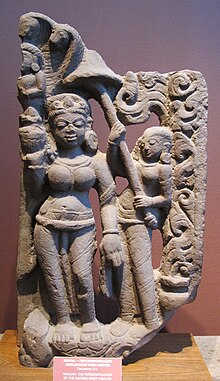
Purifying waters
Like the Ganges, the Yamuna River is highly venerated in Hinduism in the form of a river and as the goddess Yamuna. The Yamuna is considered a river of heaven. The
The Padma Purana describes Yamuna's purifying properties and states that her waters cleanse the mind from sin. It also mentions that bathing in her sacred waters frees one from the torments of death.[46] Art from the Gupta period depict Yamuna and Ganga on the entrances and doorjambs of temples and sacred places. Upon passing through these doors, visitors were symbolically purified by these rivers.[47]
Goddess personified
In her human form, Yamuna is the daughter of
Devotion
Yamuna, as a river and goddess, has a close association with
The Yamunashtakam is a 16th-century
Shlokas on Yamuna
Numerous Hindu texts have shlokas (hymns) on Yamuna as follows:
- "Yamunashtakam" by Mahaprabhu Vallabhacharya.[citation needed]
- "Simply by bathing in the Yamuna, anyone can diminish the reactions of his sinful activities." (Krishna Book, Chap 38)[citation needed]
- "By taking bath in the Yamuna River people are liberated and become Krishna conscious." (Chaitanya Charitamrita Antya 4.98 purport)[citation needed]
- "There are many devotees in Vrindavana who regularly bathe in the Yamuna, and this cleanses all the contamination of the material world." (Srimad Bhagavatam 5.8.31)[citation needed]
- "One should not give up the process of austerity. If possible, one should bathe in the water of the Yamuna. This is an item of austerity. Therefore, our Krishna consciousness movement has established a center in Vrindavana so that one may bathe in the Yamuna, chant the Hare Krishna mantra and then become perfect and return back to Godhead." (Srimad Bhagavatam 6.5.28 purport)[54]
- "The Yamuna River washed Krishna's lotus feet when the Lord appeared in Vrindavana five thousand years ago. Lord Krishna sported daily with His boys and girlfriends in the Yamuna River and consequently, that river is also caranamrita." (Srimad Bhagavatam 11.6.19)[citation needed]
- "According to the Varaha Purana as quoted by Srila Jiva Gosvami, there is no difference between the water of the Ganges and the Yamuna, but when the water of the Ganges is sanctified one hundred times, it is called the Yamuna. Similarly, it is said in the scriptures that one thousand names of Vishnu are equal to one name of Rama and three names of Lord Rama are equal to one name of Krishna." (Srimad Bhagavatam 1.19.6 purport)[citation needed]
Ecology
Fauna
The Yamuna from the source to its culmination in Ganges is a habitat for fish for approximately 1,400 km (870 mi) stretch and supports a rich diversity of species. Fish from the family
Pollution
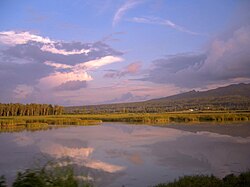
In 1909, the waters of the Yamuna were distinguishable as clear blue, when compared to the silt-laden yellow of the Ganges.[59] However, due to high-density population growth and fast industrialisation, Yamuna has become one of the most polluted rivers in the world.[60] The Yamuna is particularly polluted downstream of New Delhi, the capital of India, which dumps about 58% of its waste into the river. A 2016 study shows that there is 100% urban metabolism of River Yamuna as it passes through the National Capital Territory (NCT) of Delhi.[61] The most pollution comes from Wazirabad, from where Yamuna enters Delhi.[62]
Causes
Wazirabad barrage to New Okhla Barrage, "22 km stretch of Yamuna in Delhi, is less than 2% of Yamuna's total length but accounts for nearly 80% of the total pollution in the river",[7] 22 out of 35 sewage treatment plants in Delhi do not meet the wastewater standards prescribed by the Delhi Pollution Control Committee (DPCC), thus untreated wastewater and poor quality of water discharged from the wastewater treatment plants are the major reasons.[7] As of 2019, the river receives 800 million litres of largely untreated sewage and additional 44 million litres of industrial effluents each day, of which only 35 percent of the sewage released into the river are believed to be treated.[63] In 1994, the states of Uttarakhand, Himachal Pradesh, Uttar Pradesh, Haryana, Rajasthan and Delhi made a water sharing agreement that is due for revision in 2025. To achieve a water quality suitable for bathing (BOD<3 mg/L and DO>5 mg/L) would require a greater rate of water flow in the river. A study has recommended that 23 cubic metres (23,000 L; 5,100 imp gal) per second of water should be released from Hathni Kund Barrage during the lean season to provide a minimum environmental flow in the Yamuna.[7]
The last barrage across the Yamuna river is the
Cleanup efforts
To address river pollution, measures have been taken by the Ministry of Environment and Forests (MoEF) in 12 towns of Haryana, 8 towns of Uttar Pradesh, and Delhi, under the Yamuna Action Plan (YAP) which has been implemented since 1993 by the MoEF's National River Conservation Directorate (NRCD). The Japan Bank for International Cooperation is participating in the YAP in 15 of the towns (excluding 6 towns of Haryana included later on the direction of the Supreme Court of India) with soft loan assistance of 17.773 billion Japanese yen (equivalent to about ₹700 crore [7 billion rupees]) while the government of India is providing the funds for the remaining 6 towns. In 2007, the Indian government's plans to repair sewage lines were predicted to improve the water quality of the river 90% by 2010.[65][66][67][needs update]
Under the YAP- III scheme, a new sewage treatment plant is being built at the largest such facility in India by the Delhi Jal Board (DJB). The plant is predicted to be able to treat 124 million gallons of wastewater per day, amounting to a daily removal of 41,200 kg (90,800 lb) of organic pollutants as well as 61,600 kg (135,800 lb) of solids.[68]
In August 2009, the Delhi Jal Board (DJB) initiated its plan for resuscitating the Yamuna's 22-kilometre (14 mi) stretch in Delhi by constructing interceptor sewers, at the cost of about ₹1,800 crore (18 billion rupees).[69]
On 25 April 2014, the
The High Court in the northern Indian state of Uttarakhand ordered in March 2017 that the Ganges and its main tributary, the Yamuna, be assigned the status of legal entities, making the rivers "legal and living entities having the status of a legal person with all corresponding rights, duties and liabilities".[71] This decision meant that polluting or damaging the rivers is equivalent to harming a person. The court cited the example of the New Zealand Whanganui River, which was also declared to possess full rights of a legal person.[71]
Gallery
-
Madan Mohan temple, on the Yamuna at Vrindavan in Uttar Pradesh, 1789; the river has since shifted further away
-
'Keshi Ghat' on the Yamuna at Vrindavan in Uttar Pradesh
-
The Yamuna near Prayagraj in Uttar Pradesh, just a few kilometres before it meets the Ganges
-
The Yamuna near Prayagraj in Uttar Pradesh, during the monsoon
-
View of Yamuna from Okhla Sanctuary
-
View of Yamuna from Kesi Ghata
-
The Yamuna view from Hathni Kund Barrage
See also
- Environmental personhood
- List of rivers of India
- Western Jamuna Canal Link
- Yamuna in Hinduism
- Yamuna Pushkaram
- Yamuna Pushta
References
- ^ a b Google (5 March 2023). "Yamuna" (Map). Google Maps. Google. Retrieved 5 March 2023.
- ISBN 978-1-4020-5179-1. Retrieved 26 April 2011.
- ^ ISBN 978-1-4020-5179-1.
- ^ ISBN 0-85229-760-2.
- The Tribune (Chandigarh).
- ^ 2015, INDIA 2015, New Media Wing.
- ^ a b c d "Yamuna not fit for bathing, says govt report". The New Indian Express. 27 July 2021. Retrieved 27 July 2021.
- ^ a b PALAEOCHANNELS OF NORTH WEST INDIA, Central Ground Water Board, last page of prefce.
- ^ Yamunotri Temple Uttarkashi district website. Archived 31 July 2009 at the Wayback Machine
- ISBN 81-7035-055-7.
- ^ "Rivers of Himachal Pradesh". Webindia123.com.
- ISBN 81-8090-033-9.word, from Do-Ab, literally meaning 'two rivers', or land between two rivers".
"Doab is a Persian
- TIME, 23 February 1948.
- ^ "State of River Yamuna". Archived from the original on 13 April 2018. Retrieved 15 September 2009.
- ^ ISBN 9781402051807.
- ^ a b Rai, Raveendra Kumar; Upadhyay, Alka; Ojha, C. Shekhar P.; Singh, Vijay P. (25 November 2011). The Yamuna River Basin: Water Resources and Environment. Springer Science. pp. 114–115.
- ^ ISBN 9788120813335.
- ISBN 9780742552456.
- ISBN 81-208-1323-5.
- ISBN 90-04-09264-1.
- ISBN 0-8356-0741-0.
- ISBN 0-910261-37-7.
- ^ Clift et al. 2012. "U-Pb zircon dating evidence for a Pleistocene Sarasvati River and capture of the Yamuna River." Geology, v. 40. [1]
- ISBN 0-691-00520-6.
- ^ Upper Yamuna River Board Archived 17 January 2010 at the Wayback Machine Official website.
- ISBN 81-250-0704-0.
- ISBN 81-85182-61-2.
- Ministry of Water Resourceswebsite.
- ^ Bharati Chaturvedi, 2010, Finding Delhi: Loss and Renewal in the Megacity
- ^ Regional plan
- ^ Bharati Chaturvedi, 2010, Finding Delhi: Loss and Renewal in the Megacity, Page 78.
- ^ ML Ahmed, Analysis of Discharge and Gauge-Level Data at Old Railway Bridge, Int'l Conference on Artificial Intelligence, Energy and Manufacturing Engineering (ICAEME’2014), 9–10 June 2014, Kuala Lumpur (Malaysia).
- ^ a b c Tak, Prakash C.; Sati, Jagdish P.; Rizvi, Anjum N. (April 2010). "Status of waterbirds at Hathnikund Barrage wetland, Yamunanagar District, Haryana, India" (PDF). p. 841. Archived from the original (PDF) on 17 March 2012. Retrieved 10 July 2011.
- ^ ISBN 978-0-520-24789-5. Retrieved 2 June 2011.
- ^ a b c d Too many cooks spoil the broth , The Hindu, 29 March 2016.
- ISBN 0-226-31635-1.
- ^ a b c d e f g h i j k l m "Western yaumna Canal Project". Archived from the original on 13 November 2017. Retrieved 9 April 2016.
- ^ a b "India Water Portal" (PDF). Archived from the original (PDF) on 6 March 2016. Retrieved 9 April 2016.
- ^ a b c "Planning Commission of India: Western Yaumna Canal" (PDF). Archived from the original (PDF) on 11 February 2017. Retrieved 9 April 2016.
- ^ a b Moudgil, Rajesh (9 April 2016). "Munak water supply fully restored to Delhi". Hindustan Times.
- ^ a b Jind district profile
- ^ a b c d e f g h i Delhibird.com
- ^ Times of India. 6 April 2016.
- ^ a b Sultan, Parvez (1 February 2017). "Steamer service to revive navigation in Agra Canal after 143 years". Hindustan Times.
- ^ a b Eck, Diana L. (2012). India : a sacred geography. New York: Harmony Books.
- ^ a b c Haberman, David L. (2006). River of love in an age of pollution : the Yamuna River of northern India. Berkeley, Calif.: University of California Press.
- ^ Dallapiccola, Anna L. (2007). Indian art in detail. Harvard University Press.
- ^ Bhagavata Purana 8.13.9
- ISBN 0-87722-122-7.
- ^ "Yamunashtakam Text and Translation". Archived from the original on 25 June 2010.
- ISBN 1-84277-777-7.
- ISBN 978-0-7425-5245-6.
- ^ Gopal, Madan (1990). K.S. Gautam (ed.). India through the ages. Publication Division, Ministry of Information and Broadcasting, Government of India. p. 72.
- ^ "Yamuna River", Mathura-Vrindavan
- ^ Sharma, H.S., 2007. Freshwater Fishes. Fauna of Madhya Pradesh (including Chhattisgarh), State Fauna Series, 15(1), pp.147–244.[2]
- ^ Sharma, A.P., Das, M.K., Samanta, S., Paul, S.K. and Bhowmick, S., 2014. The ecology and fishery status of river Yamuna. Bulletin, (184), pp.1–32.http://citeseerx.ist.psu.edu/viewdoc/download?doi=10.1.1.709.760&rep=rep1&type=pdf
- ^ "Lang, J.W., Chowfin, S. and Ross, J.P., 2019. Gavialis gangeficus".
{{cite journal}}: Cite journal requires|journal=(help) - ISBN 978-0-520-93962-2.
- ^ The Ganges and the Jumna The Imperial Gazetteer of India, 1909 v. 1, p. 23.
- PMID 30802637.
- ^ "Urban Metabolism of River Yamuna in the National Capital Territory of Delhi, India". ResearchGate. Retrieved 25 November 2020.
- ^ Sharma, Manju & Chaudhry, Smita. (2015). Impact of Industrial Pollution on Yamuna River: A Review. 10.13140/RG.2.1.3632.8401.
- ^ Sukanan, Darunee (26 November 2019). "A 'sacred' river in India has become polluted beyond belief". Sustainability Times. Archived from the original on 28 November 2019. Retrieved 28 November 2019.
- ^ "list of head works (Dams,_Barrages, Weirs, Anicuts, Lifts) on Yamuna/Ganga river". Retrieved 14 May 2015.
- ^ Pepper, Daniel (27 July 2007). "India's 'flush-and-forget' mindset". SFGate.com. San Francisco Chronicle. pp. A17–A18. Retrieved 27 July 2007.
- Indian Express. 8 April 2000.
- ^ Pepper, Daniel (4 June 2007). "India's rivers are drowning in pollution". Fortune.
- ^ "India's largest sewage treatment plant to come up at Okhla: DJB". The Economic Times. 29 May 2019. Retrieved 28 November 2019.
- Indian Express. Archived from the originalon 14 January 2012.
- ^ "Panel: Scrap Yamuna riverfront project". Delhi Daily News. 26 April 2014. Archived from the original on 16 July 2014.
- ^ ISSN 0261-3077. Retrieved 25 March 2019.
Further reading
- Fraser, James Baillie (1820). Journal of a tour through part of the snowy range of the Himala Mountains, and to the sources of the rivers Jumna and Ganges. Rodwell and Martin, London.
- Haberman, David L. (2006). River of love in an age of pollution: the Yamuna River of northern India. ISBN 0-520-24790-6.
- Schumann, A. H. (2001). Sustainable regional water management of Yamuna river basin: A case study. ISBN 1-901502-51-1.
External links
- The Geography of the Rigveda Archived 15 January 2018 at the Wayback Machine
- Yamuna Action Plan
- The Yamuna, India's most polluted river on YouTube. The Guardian(7 July 2017)
- Yamuna Mission
- The painting A Ruin on the Banks of the Jumna, Above the City of Delhi by William Purser, engraved by William Joseph Taylor, as an illustration to
 The Zenana., a poem by Letitia Elizabeth Landon.
The Zenana., a poem by Letitia Elizabeth Landon.



